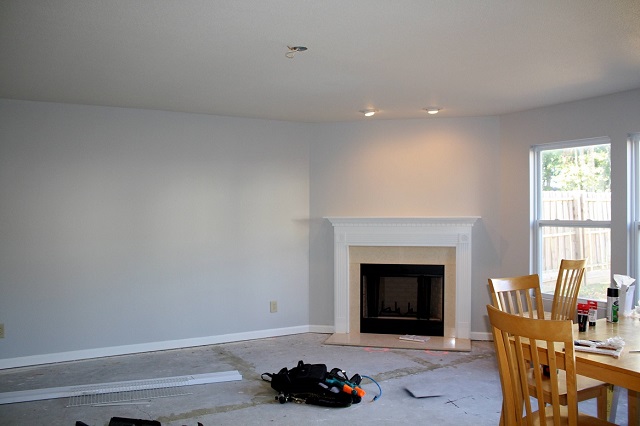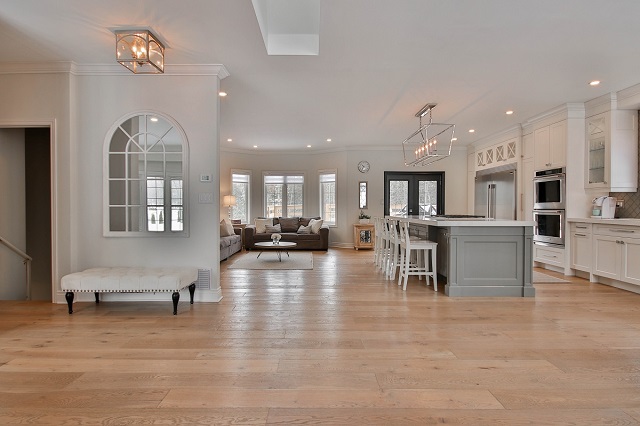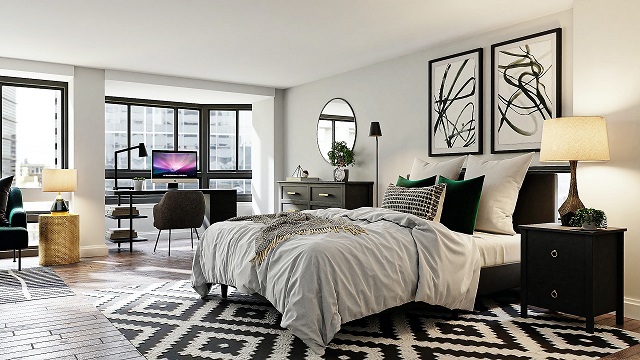Table of Contents
Looking for a professional interior painting company to transform your home? Look no further! Hiring an experienced team is essential for achieving flawless results. Discover expert tips, techniques, and insider knowledge that will help you make informed decisions when it comes to refreshing your living space. Don’t settle for anything less than perfection – delve into our comprehensive guide now!
Importance of Interior Painting
Interior paint plays a vital role in enhancing the aesthetics and value of your home. The right choice of colors and finishes can transform a dull and boring space into a vibrant and welcoming one. Whether you’re planning to sell your home or simply want to create a more inviting and pleasant atmosphere for your family and guests, a fresh coat of paint can make a world of difference.
Not only does interior painting enhance the visual appeal of your home, but it also adds value to your property. Potential buyers are often drawn to houses that are well-maintained and visually appealing. A well-executed paint job can give the impression of a well-cared-for home, making it more appealing to potential buyers and potentially increasing its resale value. Additionally, when you invest in quality paint and proper application techniques, you can expect your paint job to last longer, thereby reducing the need for frequent touch-ups or repairs, which can save you money in the long run.
Choosing the Right Colors
When it comes to choosing the right colors for your home’s interior painting, it’s important to consider the psychological and emotional impact that different hues can have. Colors have the power to evoke specific feelings and moods, and understanding this can greatly enhance the overall ambiance of your living spaces. For example, warm tones such as reds, oranges, and yellows can create a cozy and inviting atmosphere, while cooler shades like blues and greens can promote relaxation and tranquility. By combining different colors and experimenting with their placement, you can create a cohesive and visually appealing environment that reflects your personal style and enhances your home’s aesthetics.
In addition to influencing mood, color selection can also have an impact on the perceived size and shape of a room. Lighter colors tend to make a space feel larger and more open, while darker shades can create a sense of intimacy and coziness. If you have a small room that you want to appear larger, opting for lighter colors like white, cream, or pastels can help create the illusion of more space. On the other hand, if you have a large and open area that you want to feel more intimate, selecting darker colors like navy blue or deep brown can bring a sense of warmth and coziness. By understanding the psychological and visual effects of different colors, you can make informed choices that will transform your living spaces into rooms that reflect your personality and contribute to a harmonious and balanced home environment.
Preparing Your Walls

Before you start painting your walls, it is crucial to adequately prepare the surface for a flawless finish. One of the primary steps in this process is cleaning the walls thoroughly. Dust, dirt, and grease can affect the adhesion of the paint, leading to an uneven and unsatisfactory result. Using a mild detergent mixed with water, gently scrub the walls with a sponge or cloth to remove any residue. Pay close attention to areas like the kitchen and bathroom, which may have accumulated more grime over time. Once cleaned, allow the walls to dry completely before moving on to the next step.
After the walls are clean and dry, the next essential step is to repair any cracks, holes, or imperfections on the surface. Small cracks or nail holes can easily be filled using spackle or joint compound. Use a putty knife to apply the filler and ensure a smooth finish. For larger holes or damaged areas, it may be necessary to use a patching compound or even replace sections of drywall. Allow the filler or patching compound to dry completely before sanding it down gently to create a level surface. Taking the time to properly repair and prepare your walls will contribute greatly to the overall quality of your paint job.
Exploring Different Interior Painting Techniques
One of the most exciting aspects of interior painting is the opportunity to experiment with different techniques that can add texture and depth to your living spaces. By using techniques such as color washing, sponging, or rag rolling, you can create unique effects that can transform the look and feel of your walls. Color washing, for instance, involves applying a translucent glaze over a base coat to create a soft, muted effect that adds depth and dimension to the walls. Similarly, sponging and rag rolling techniques involve dabbing or rolling a sponge or rag onto the walls to create a textured look that adds visual interest.
Not only do these painting techniques add visual appeal to your interiors, but they can also help to disguise imperfections on your walls. Whether it’s hiding minor cracks or uneven surfaces, these techniques can provide an effective solution, giving your walls a flawless finish. By adding texture and depth, you can bring a whole new level of character and style to your living spaces, making them more visually captivating and inviting. So, don’t be afraid to get creative and experiment with different painting techniques to achieve a versatile and personalized interior design.
Selecting the Right Paint Finish
When it comes to selecting the right paint finish for your interior walls, there are a few key factors to consider in order to achieve the desired look and durability. One of the first things to think about is the location of the room and its purpose. For high-traffic areas like hallways and living rooms, a paint finish with a higher sheen, such as satin or semi-gloss, is often recommended. These finishes are more resistant to stains and can be easily wiped clean. On the other hand, if you’re painting a bedroom or a space where you want a softer, more relaxed ambiance, a flat or matte finish may be the way to go. These finishes provide a smooth, velvety appearance but may be less resistant to wear and tear.
In addition to considering the location and purpose of the room, it’s also important to think about the overall style and aesthetic you want to achieve. Different paint finishes can create different effects and contribute to the overall mood of the space. For example, a glossy finish can add a touch of elegance and sophistication, while a matte finish can create a more understated and contemporary look. It’s a good idea to experiment with sample swatches on your walls to see how different finishes interact with the lighting and furnishings in the room. This will help you determine which paint finish aligns best with your vision and desired outcome.
Exploring Eco-Friendly Paint Options
Eco-friendly paint options have gained popularity in recent years due to their minimal impact on the environment. These paints are typically made from natural and non-toxic ingredients, making them safe for both human health and the planet. By choosing eco-friendly paints, homeowners can enhance the beauty of their homes while also being environmentally conscious.
One of the key benefits of eco-friendly paint is its low emission of volatile organic compounds (VOCs). VOCs are chemicals that are released into the air as paint dries, contributing to indoor air pollution. Traditional paints often contain high levels of VOCs, which can have detrimental effects on human health, including respiratory issues and headaches. Eco-friendly paints, on the other hand, have significantly reduced levels of VOCs or are even VOC-free, making them a healthier choice for your home and family.
DIY Painting: Interior painting on Your Own
Painting your interiors can be a rewarding and cost-effective way to refresh the look of your home. With some basic knowledge and the right tools, you can achieve professional-looking results on your own. Before you start, it’s important to prepare your space by cleaning and prepping your walls. Remove any loose paint or wallpaper, fill in any holes or cracks, and sand the surface to create a smooth canvas. Be sure to cover furniture and floors with drop cloths or plastic sheets to protect them from any accidental spills or splatters.
Once your space is prepped, it’s time to choose the right paint colors for your interiors. Consider the mood you want to create in each room and how different colors can impact the overall atmosphere. Warm colors like reds and yellows can create a cozy and inviting feel, while cool colors like blues and greens can promote a sense of calm and relaxation. Remember to test your chosen colors on a small area of the wall before committing to the entire space. This will give you a better idea of how the color will look in different lighting conditions.
Hiring Professional Painters for a Stress-Free Experience
When it comes to painting your home’s interiors, hiring professional painters can offer several benefits and considerations for a stress-free experience. One of the key advantages is the expertise and experience that professional painters bring to the table. They have a deep understanding of color schemes, painting techniques, and finishes, allowing them to deliver flawless results. Additionally, professional painters have access to high-quality tools and materials, ensuring that the paint job not only looks good but also lasts longer.
Another benefit of hiring professional painters is the time and effort saved. Painting an entire home can be a time-consuming and physically demanding task. By hiring professionals, you can free up your time to focus on other important tasks or simply relax. Moreover, professional painters are well-equipped to handle any challenges that may arise during the painting process, such as repairing damaged walls or addressing moisture issues. Their expertise and attention to detail can give you peace of mind and ensure that the job is completed to your satisfaction.
Budgeting and Estimating for Your Interior Painting Project
Budgeting and estimating for your interior painting project is crucial to ensure that you have a clear understanding of the cost factors involved. Before diving into this undertaking, it’s important to consider various aspects that can impact the overall expenses. One of the primary factors to consider is the size of the area to be painted. The bigger the space, the more materials and labor will be required, thus potentially increasing the cost. Additionally, the condition of the walls is another factor that can affect the budget. If there are repairs or extensive preparation needed, such as patching holes or sanding rough surfaces, it will add to the overall expenses. By carefully analyzing these elements, you can create a realistic budget that aligns with your financial capabilities.
Another crucial aspect to consider when budgeting for your interior painting project is the quality of paint you choose. While it may be tempting to opt for cheaper options, it’s essential to weigh the long-term benefits against the upfront cost. Investing in high-quality paint can not only provide a better finish but also ensure durability and longevity. Additionally, the number of coats required will impact the cost as well. While some paints may require multiple coats to achieve the desired result, others may provide excellent coverage with a single coat, saving you both time and money. Taking these factors into account when estimating the expenses will help you make informed decisions and ultimately achieve a successful interior painting project that fits your budget.
Prolonging the Lifespan of Your Interior Painting Job
Proper maintenance and care are essential for maintaining the longevity and appearance of your interior painting job. To ensure that your walls continue to look fresh and vibrant, it is important to follow a few simple steps. Firstly, regularly dust and clean your walls using a soft cloth or sponge to remove any dirt or grime that may have accumulated. Avoid harsh cleaning agents as they can damage the paint. Additionally, be cautious when placing objects on your walls, as excessive pressure or friction can cause the paint to chip or peel. To prevent this, use protective pads or felt strips behind frames and other hanging objects.
Another crucial aspect of maintaining your interior painting is addressing any signs of damage or wear. Keep an eye out for cracks, stains, or peeling, and promptly address these issues to prevent further deterioration. Small touch-ups can often be done easily using leftover paint or off-the-shelf touch-up kits. For larger areas of damage, it may be necessary to repaint the affected section. Regularly inspecting your walls and attending to any issues promptly will help prolong the lifespan of your interior paint job.



